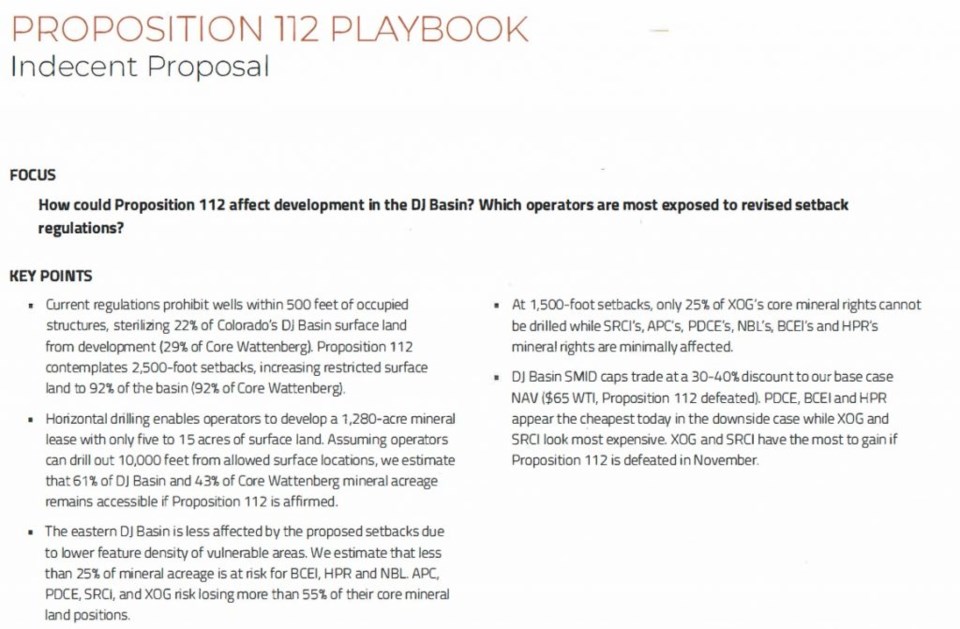This content was originally published by the Longmont Observer and is licensed under a Creative Commons license.
On October 24, 2018, RS Energy released a report on the impact Proposition 112 would have on the oil and gas industry drilling in the Denver-Julesburg Basin, especially the Wattenberg Oil Field. The report's key points appear to run counter to the oil and gas industry position that Proposition 112 would be effectively a ban on oil and gas production in the state of Colorado:

The key point:
"Horizontal drilling enables operators to develop a 1,280-acre mineral lease with only five to 15 acres of surface land. Assuming operators can drill out 10,000 feet from allowed surface locations, we estimate that 61% of DJ Basin and 43% of Core Wattenberg mineral acreage remains accessible if Proposition 112 is affirmed."
is an eye-catcher and seems to agree with Dr. Peter Maniloff, assistant professor of economics at the Colorado School of Mines, in his October 2018 paper "A Note on the Impacts of Proposition 112." Maniloff points out that the industry is conveniently leaving out the impact of access to subsurface oil and gas deposits when making their claims:
"[ . . .]I calculate what area of the subsurface is within one mile of a surface location which would remain accessible under Prop 112. That is, how much of the subsurface would be available, assuming that firms could drill horizontally for one mile from any accessible surface location."
"I find that 42% of the non-federal subsurface would be accessible, or nearly three times the available surface area [found in the Colorado Oil and Gas Conservation Commission analysis]."
RS Energy analysis used a less conservative figure of 10,000 feet (~ 2 miles) for horizontal well drilling distance versus Maniloff's 1 mile. They added in the assumption that horizontal drilling infrastructure would need up to 7.5 acres for a viable drill site - something that Maniloff left out of his analysis according to critics. All in, RS Energy and Maniloff get surprisingly similar numbers.
Not so fast, says Heather Huften, Media Manager for RS Energy Group. When contacted about a second paper drafted to clarify statements made in the original paper, Ms. Huften emailed a statement from Co-CEO Manuj Nikhanj that adds a new wrinkle to the controversy:
"We did not do a detailed examination of “drilling inventory” for the basin as a whole. As a result, the 61% and 43% “accessible mineral acreage” were mistakenly interpreted as remaining “drilling inventory” which it is not. To calculate remaining “drilling inventory”, you need to take into account wells that have already been drilled on this “accessible land”, average spacing per well and geologic and surface considerations. The follow-up report reviews “drilling inventory” for the 43% accessible mineral acreage in Core Wattenberg."
When drilling inventory is taken into account, Nikhanj says a dire picture emerges where the estimated 6,500 drilling locations drop to around 1,000 and that will force operators to drill sub-optimal wells at a higher cost. Ultimately, that could make the Wattenberg Field less competitive against other basins that multi-basin operators can drill in. These operators can shift capital to more competitive plays outside Colorado.
Seems oil and gas companies aren't quite ready to abandon Colorado, though.
Catherine Traywick, Editor for Bloomberg, has been following recent earnings calls by oil and gas concerned by Proposition 112 and tweets:
"Highpoint Resources has developed alternate development plans that would enable it to access most of its acreage, albeit at a higher cost.
And Noble Energy, with 350k acres in Colorado, said that "proactive permitting" is key to protecting drilling inventory before the vote."



